|
 Phylloporus novae-zelandiae Phylloporus novae-zelandiae
BiostatusPresent in region - Indigenous. Endemic
Images (click to enlarge)
Caption: Phylloporus novae-zelandiae: c, cystidia: d, spores | 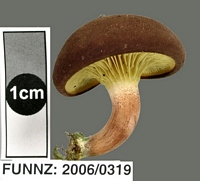
Caption: FUNNZ: 2006/0319, See public note for more information
Owner: FUNNZ | 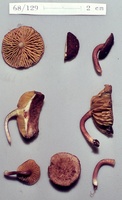
Caption: ZT68-129
Owner: E. Horak: © Creative Commons Attribution-Noncommercial 3.0 New Zealand | 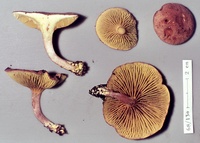
Caption: ZT68-130
Owner: E. Horak: © Creative Commons Attribution-Noncommercial 3.0 New Zealand | 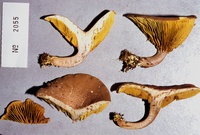
Caption: ZT2055
Owner: E. Horak: © Creative Commons Attribution-Noncommercial 3.0 New Zealand | 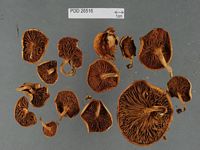
Caption: Dried type specimen
Owner: Herb PDD | 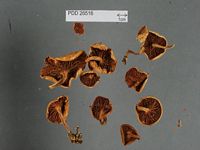
Caption: Dried type specimen
Owner: Herb PDD | 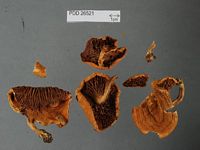
Caption: Dried type specimen
Owner: Herb PDD | |
Article: McNabb, R.F.R. (1971). Some new and revised taxa of New Zealand Basidiomycetes (Fungi). New Zealand Journal of Botany 9(2): 355-370 (http://www.rsnz.org/publish/abstracts.php).
Description: Pileus plano-convex, applanate, or centrally depressed, 2.5-9.5 cm diam., dry, finely felted, occasionally faintly creviced near margins at maturity, sometimes with a sooty appearance, dark brown when young becoming paler at maturity and then cocoa brown, mid-brown, or faintly yellowish brown; cuticle a trichodermium, composed of erect, branched, short-celled, septate hyphae 12-18 µm diam., with brownish contents. Individual cells inflated to varying degrees, terminal cells unspecialised but tending to become bluntly acuminate apically; margins strongly involute when young, moderately so at maturity, entire, sterile. Hymenophore lamellate, lamellae decurrent, non-meruloid at junction with stipe, moderately thick, blunt edged, simple or irregularly branched and anastomosing, often crinkled with sides of lamellae transversely venose, to 4 mm deep, bright yellow, slowly staining greenish blue where damaged. Stipe 2.5-5.5 cm long, tapering basally with extreme base slightly bulbous, 0.5-1.5 cm diam., solid, dry, finely felted, slightly paler than pileus, pallid yellow apically and at extreme base; flesh pallid brownish white; basal mycelium yellow.
Spores olive brown in print, melleous, elliptic-subfusiform, apiculate, suprahilar depression or applanation present, 9-13 x 3.8-4.5 µm, smooth. Hymenium composed of basidia and cystidia; basidia hyaline, clavate, 33-45 x 8-10 µm, 4-spored: cystidia scattered, hyaline, thin-walled, ventricose-rostrate, 50-75 x 9.5-16.5 µm, projecting to 30 µm beyond basidia. Hymenophoral trama bilateral, of the Phylloporus subtype, hyphae of lateral stratum only slightly divergent; clamp connections absent. Context of pileus pallid yellow, unchanging. Taste mild. Chemical characters: KOH on pileus- darkening with reddish brown tints; on context-salmon pink: NH4OH on pileus darkening with red, flush; on context-n.r.
Habitat: Scattered, gregarious, or occasionally caespitose under Nothofagus.
Notes: Singer (1962) recognised four species of Phylloporus, of which only P. rhodoxanthus (Schw.) Bres. was considered completely known. The remainder were known from dried specimens only. Phylloporus rhodoxanthus was regarded by Singer (1945) as a more or less cosmopolitan species composed of four subspecies. The combination of the unchanging context, slow bluing of damaged lamellae, and the absence of a bright blue colour reaction with ammonia distinguish P. novae-zelandiae from all subspecies of P. rhodoxanthus. A positive colour reaction with ammonia was considered of generic significance by Singer (1945) but on the present information, it appears to be restricted to P. rhodoxanthus. Despite the fact that Phylloporus is a lamellate genus, the limits between the Boletaceae and strictly lamellate families of Agaricales are clearly defined since the blue discolouration of the damaged hymenophore or context does not occur in closely related families such as the Paxillaceae.
No species have previously been described from New Zealand although both Heim (1950) and Horak (1970) reported that Phylloporus was represented in the fungal flora of the country. An Australian species P. hyperion (Cooke & Mass.) Singer, was recorded from New Zealand by Massee (1898) but Singer (1955) showed that the collection on which this record was based was a species of Gymnopilus (Cortinariaceae).
|